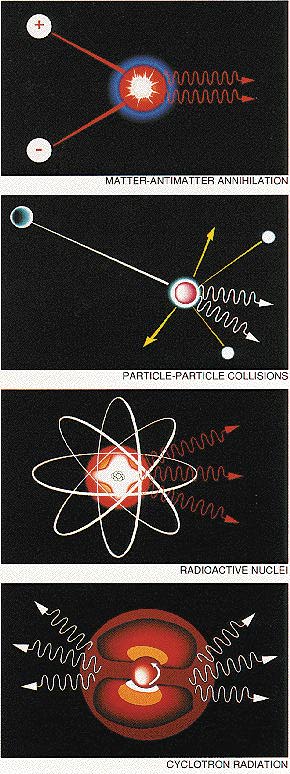RIGHT: Some of the fundamental physical interactions which result in gamma-ray line emission. Other processes can produce gamma rays over broad energy ranges

| The main processes taking place have names like
pair annihilation (particles and antiparticles destroying each other with
the result being gamma-ray emission), Compton scattering (wherein a charged
particle collides with a photon - changing the energy and direction of
the photon), and synchrotron emission (the photons emitted when relativistic
charged particles travel in a magnetic field). The means by which gamma-ray
photons are created are also related to how these photons are detected.
The nonthermal processes are the key to how instruments detect high-energy
photons. Unlike optical and x-ray photons, gamma rays cannot be focussed
by a mirror - they simply pass through thin materials. Paradoxically, one
of the reasons gamma rays are valuable is that they are less affected by
their environment than lower energy photons, thus providing a more pristine
view of the source. Interactions within gamma-ray detectors such as pair
creation, Compton scattering and nuclear excitation - those processes which
give rise to the photons at the cosmic source - are used to measure the
time of gamma-ray arrival and energy. Gamma-ray instrumentation relies
on detection techniques developed in the world of high-energy physics.
Phototubes . . . spark chambers . . . scintillators . . . collimators .
. . these are some of the terms in the lexicon of gamma-ray instrument
builders. Putting all these devices together into a coherent mission to
investigate the unexplored gamma-ray universe was the challenge of the
Compton Gamma Ray Observatory Project.
RIGHT: Some of the fundamental physical interactions which result in gamma-ray line emission. Other processes can produce gamma rays over broad energy ranges |
 |